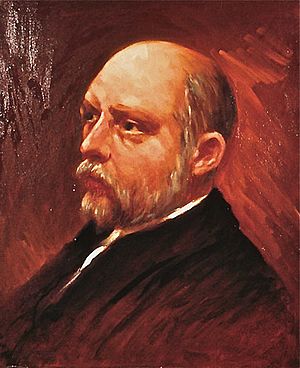T. S. Sullivant facts for kids
Quick facts for kids T. S. Sullivant |
|
|---|---|

Portrait of Sullivant by Thomas P. Anshutz (1895)
|
|
| Born | Thomas Starling Sullivant 1854 Columbus, Ohio, United States |
| Died | 1926 (aged 71–72) |
| Nationality | American |
| Area(s) | Cartoonist |
Thomas Starling Sullivant (born 1854, died 1926) was a famous American cartoonist. He signed his drawings as T. S. Sullivant. His cartoons often appeared in a funny magazine called Life.
Sullivant was well-known for drawing animals and different kinds of people in a very funny, exaggerated way. He also created political cartoons and illustrated books for children. His drawing style used lots of fine lines to create shading, and he made people and animals look very funny with huge features, but he still understood how their bodies really worked.
Sullivant's Unique Drawing Style
Thomas Sullivant was an artist who worked with pen and ink. This was a popular style where artists used many tiny lines, called cross-hatching, to create shadows and depth in their drawings. Other famous artists like Charles Dana Gibson also used this technique.
Sullivant, along with artists like A. B. Frost and E. W. Kemble, loved to play with how they drew. They would twist and stretch body parts, change how things looked in perspective, and make their drawings feel alive. A cool thing Sullivant did was make the heads of his characters much bigger than normal. This became more and more exaggerated in the 1890s, and many other artists started doing it too!
Sullivant was especially famous for his funny animal drawings and his different character types. He drew people from various walks of life, like farmers, travelers, and families living in the suburbs. His animals looked strange but also very real. They were super detailed and correct in their body shapes, even though they were greatly exaggerated. You could see their moods and feelings clearly in his drawings.
He learned a lot about how bodies move from Eadweard Muybridge's photos of humans and animals in motion. Often, the funny part of Sullivant's cartoons was all in the pictures and the action, not just the words. The captions sometimes added very little to the joke.
Sullivant was a perfectionist. He often used razor blades on his drawings, not to create shading like some artists, but to scratch out parts he didn't like. This way, he could draw over the paper again, saving only the parts of the drawing he loved. Another cartoonist, Frederick Burr Opper, who created Happy Hooligan, once joked about Sullivant's razor use: "If Tom Sullivant scratched his head as much as his paper, he'd draw better cartoons!"
As Sullivant got older, his drawings became simpler, looser, and even more exaggerated. Some experts, like animator Nancy Beiman, believe his best work was done when he was in his sixties.
Sullivant's Lasting Influence
Thomas Sullivant had a big impact on many other cartoonists. For example, Walt Kelly, who created the Pogo comic strip, had one of Sullivant's original drawings, "The Naming of the Animals," hanging above his studio door. Jim Woodring also wrote an important article about Sullivant for The Comics Journal.
Sullivant was also hugely important in the early days of American animation, almost as much as Winsor McCay. He especially influenced the artists at Disney studios. A person named T. Hee brought a collection of Sullivant's drawings to Disney to inspire the "Dance of the Hours" part of the movie Fantasia. You can also see Sullivant's influence in the Walrus character in Alice in Wonderland and the elephants in Dumbo. T. Hee even continued to use these drawings when he taught at the California Institute of the Arts until the 1980s. Other animators who were inspired by Sullivant include John Randolph Bray and Nancy Beiman.
Books by Thomas Sullivant
- Fables for the Times (1896): This book collected a series of cartoons called "Aesop to Date" that first appeared in Life magazine.
- Sullivant's ABC Zoo (1946): This is a collection of his funny animal cartoons.

